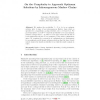Free Online Productivity Tools
i2Speak
i2Symbol
i2OCR
iTex2Img
iWeb2Print
iWeb2Shot
i2Type
iPdf2Split
iPdf2Merge
i2Bopomofo
i2Arabic
i2Style
i2Image
i2PDF
iLatex2Rtf
Sci2ools
GECCO
2004
Springer
2004
Springer
On the Complexity to Approach Optimum Solutions by Inhomogeneous Markov Chains
We analyse the probability 1 − δ to be in an optimum solution after k steps of an inhomogeneous Markov chain which is specified by a logarithmic cooling schedule c(k) = Γ/ ln (k + 2). We prove that after k > (n/δ)O(Γ ) steps the probability to be in an optimum solution is larger than 1 − δ, where n is an upper bound for the size of local neighbourhoods and Γ is a parameter of the entire configuration space. By counting the occurrences of configurations, we demonstrate for an application with known optimum solutions that the lower bound indeed ensures the stated probability for a relatively small constant in O(Γ).
| Added | 01 Jul 2010 |
| Updated | 01 Jul 2010 |
| Type | Conference |
| Year | 2004 |
| Where | GECCO |
| Authors | Andreas Alexander Albrecht |
Comments (0)

